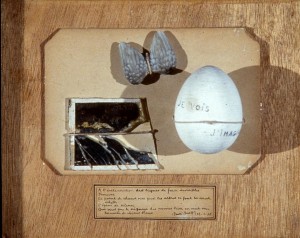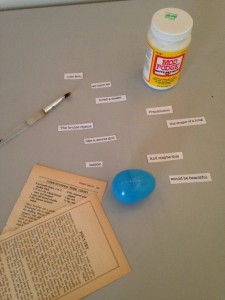I’ve been thinking a lot about tangibility lately. Why is it important to touch objects?What does their tactility express? What does it mean that to hold something is know it in some inexplicably intimate way?
A project I’m interested in exploring in upcoming Pages visits is the idea of a poem object. I’d love to see how students respond not only to mixed media, but also to the concept of tactile poetry as we think about The Object Lesson.
I was inspired by Poèm Objet by surrealist artist Andre Breton. This mesmerizing collage incorporates wood, object and poetry in one piece. Translated, the inscription on the plaster egg reads “I see / I imagine.”
I don’t consider myself a visual artist in any capacity so this project stretched me. Yet, I was challenged by the notion of “seeing” or “imagining” things in a new way.
A bit of process: First I found lines in my poetry I wanted to represent tactilely. Using a vintage cook book, I shredded the pages and applied them to plastic eggs. I used these reinvented books (book-eggs?) as pages€¯ for my poetry.
It became all about new ways of seeing and reimagining what I thought was even possible for my poems. But I found something about the practice of making things with my hands is jubilant, ripe, necessary. Through touch, I was reminded what is to love, hold, cradle, caress, find, and know.
Let me know if you’d like me to try this out with students coming up!
–Joy Sullivan



This is a lovely way to touch the words, give them new life, new depth, see them as text and object. This is another way to write with students, get them using a different sense they rarely get to use, the tactile, the sense of touch to write.